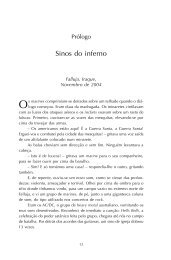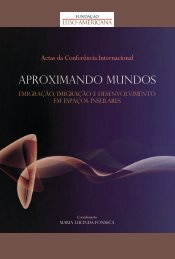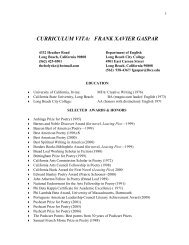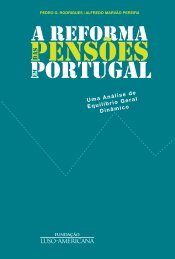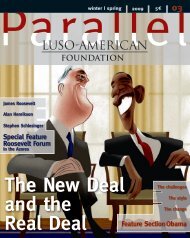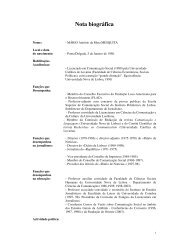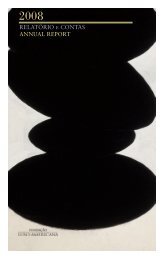A decade later - Fundação Luso-Americana
A decade later - Fundação Luso-Americana
A decade later - Fundação Luso-Americana
Create successful ePaper yourself
Turn your PDF publications into a flip-book with our unique Google optimized e-Paper software.
Seated in his regal chair, King Luis I of Portugal listens rapt to<br />
the adventures of the inveterate seductress Laureana, who was<br />
in turn seduced by Giovellino, the lyrical persona of the Count<br />
of Florence.<br />
The plot of the opera by Augusto Machado (1845-1924) unfolds<br />
in four acts and six scenes. The libretto, by Jean-Jacques Magne<br />
and A. Guiou is taken from the novel Les Beaux Messieurs de Bois-Doré<br />
by Georges Sand and Paul Maurice. Dedicated to His Majesty Luis<br />
I, the opera debuted on March 1, 1884 at the São Carlos National<br />
Theater and today warrants a place of honor in the history books<br />
as a milestone in... Portuguese telecommunications.<br />
‘ His majesty was able to happily hear the whole opera,<br />
in the comfort of his own home, without the customary<br />
courtly etiquette and gris perle gloves of the royal<br />
box, seated on his throne draped in his ermine mantle,<br />
or tucked in bed with a woolen cap on his head,<br />
depending on his wishes and bodily needs.<br />
’<br />
António Maria magazine, March 6<br />
Still in mourning for his sister, Maria Ana de Bragança, Princess<br />
of Saxony, and unable to leave the palace, the king decided to<br />
commission an audition of the opera live via the theaterphone, a<br />
recent invention by Clément Ader, first tested in Paris in 1881.<br />
Placed in a semi-circle downstage on pedestals with rubber<br />
feet to absorb vibration, six microphones – powered by three<br />
sets of serial-connected batteries, alternating every 20 minutes<br />
to guarantee power input stability – performed the miracle of<br />
capturing and transmitting the performance. Thus, the king and<br />
queen were able to accompany the opera from start to finish,<br />
despite intermittent distortions, soundbursts, and the odd clunker<br />
produced by the orchestra, singers, and chorus.<br />
In the March 6th edition of the almanac António Maria, Rafael<br />
Bordalo Pinheiro published a caricature that was to immortalize<br />
the event. The caption, by Alfredo de Morais Pinto, whose pen<br />
name was Pan, quipped: “His Majesty was able to happily hear<br />
the whole opera, in the comfort of his own home, without the<br />
customary courtly etiquette and gris perle gloves of the royal box,<br />
78<br />
riGHT To WriTe D.R.<br />
“Laureana,” the theaterphone,<br />
and a king’s pioneering spirit<br />
mAnueL siLvA pereirA*<br />
seated on his throne draped in his ermine mantle, or tucked in<br />
bed with a woolen cap on his head, depending on his wishes<br />
and bodily needs.”<br />
Spurred on by success, the Teatro São Carlos promoted its 1885<br />
opera season with opera lovers being able to subscribe to the<br />
theaterphone. For 180 thousand reis, the listener got 90 recitals.<br />
It didn’t matter whether the subscriber lived in Palhavã, Olivais,<br />
or Braço de Prata, because the soundwaves generated by the Ader<br />
device arrived in perfect condition.<br />
According to the Le Times, for this huge achievement, the director<br />
of the Edison Gower Bell Company, who installed the dedicated<br />
phone line between Teatro de São Carlos and<br />
the royal palace in Ajuda would <strong>later</strong> be dec-<br />
orated with the Military Order of Christ!<br />
The system was only commercialized in<br />
France in 1890, five years <strong>later</strong>, and though<br />
the monarch’s other deeds may have been<br />
relegated to the dustbin of history, this<br />
delightful caprice of music-lover Luis the<br />
First is mentioned in a number of sources.<br />
Less widely publicized though was the interest<br />
and admiration the Metropolitan Opera<br />
House in New York displayed toward this<br />
breakthrough Lusitanian invention.<br />
For almost eight <strong>decade</strong>s now opera has<br />
been broadcast live over the radio, allowing millions of listeners<br />
to enjoy the best productions around. And in 2002, some of the<br />
world’s major opera productions, staged in countless theaters<br />
and concert halls, began to be televised in HD-TV from and to<br />
nearly 40 countries around the world.<br />
Interested in tracing the history of this new cycle of globalization,<br />
which has sparked the interest of opera lovers and captured<br />
new audiences worldwide, the MET – and particularly the people<br />
responsible for their Live in HD program- once again resuscitated the<br />
story of Adler’s theaterphone and the Portuguese king’s daring<br />
initiative. When I personally contacted our only opera house to<br />
obtain some names and addresses, and to ask for their help in<br />
doing some in-depth research into their files, I was dumbfounded<br />
by their off-putting response, “Don’t tell me we’re going to<br />
have to write down the whole history for you!,” they grumbled.<br />
So much for the pioneering spirit!<br />
* Former aide to the Portuguese embassy in Washington DC and to the Portuguese UN Mission<br />
in New York.<br />
Parallel no. 6 | FALL | WINTER 2011








